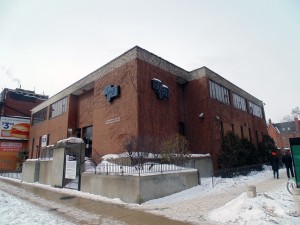
The relatively unobtrusive building currently at Madison Avenue and Bloor Street once housed the Boy Scouts of Canada and, until recently, the Restaurant Association of Canada. Photo: Brian Burchell, Gleaner News
Community members decry proposed Madison Avenue condominium
By Annemarie Brissenden
A developer’s proposal to raise a 42- to 45-storey, 535-unit condominium tower at 316 Bloor St. W. was met with jeering skepticism during a packed standing-room-only community consultation hosted by Joe Cressy (Ward 20, Trinity-Spadina) on Apr. 2.
The developer, State Building Group/Forest Hill Homes, fielded a team of representatives at the meeting. They included urban planner Peter Smith of Bousfields Inc., architect David Butterworth of Kirkor Architects & Planners, and a landscape architect from NAK Design Strategies tasked with “enhancing” Paul Martel Park in conjunction with the project. The large team endeavoured to convince Annex residents that the location at Bloor Street and Madison Avenue, with its proximity to two major transit interchanges, a high measure of walkability, and little recent development activity in the immediate area, was appropriate for intensification.
That justification, however, fell on deaf ears.
“Why does developing a neighbourhood always involve disadvantaging the stuff that’s already there?” asked a resident of 95 Prince Arthur Ave., who was also concerned that the proposed tower would overshadow the gardens on her building’s rooftop and in its courtyard.
Smith responded that unlike the “more massive slab style buildings” marking the area, the proposed slim, compact tower devoid of balconies would minimize any potential shadowing.
Butterworth, who previously worked on the Minto building at Yonge Street and Eglinton Avenue, added that the development would consist of small, compact one-bedroom and studio high-end professional units targeted at “young professional end users”. There would be a small number of parking spaces, some provisions for car sharing, and upscale amenities that might include a coffee bar or lounge.
Instead of reassuring those at the meeting, such information served only to heighten the concerns of community members, who made their feelings known during a lively question and answer session.
Tim Grant, chair of the Harbord Village Residents’ Association, was met with loud applause when he explained that local residents are “acutely sensitive to excessively high buildings. The problem is [that] 10 more buildings [will result from] this precedent, and create massive shadowing.”
“Clearly there are many issues to deal with,” said David Harrison, chair of the Annex Residents’ Association (ARA), who added that he was “astonished that no rationalization has been given for 42 storeys”. He characterized the building — “too tall [and] too dense” — as a “vertical rooming house”.
With the area set to absorb three potential student residential towers in the next decade, it’s a comment that resonated with many at the meeting.
Some fear that a condominium tower comprised largely of one-bedroom studios would not attract young, high end urban professionals as anticipated, but instead be purchased by investors who would in turn rent out the units to “transient” university students.
“With that kind of size, they are not going to stay long,” said a speaker from Robert Street. “What do they offer to [our] community?”
A St. George Street resident, who is “concerned about students renting from overseas entrepreneurs”, also struck a chord while responding to the developer’s plans for Paul Martel Park.
“Don’t offer us benefits that we already have,” he said. “I resent comments that suggest we could enhance the park.”
Named in honour of a cherished Annex resident, the small green space on Madison Avenue is near and dear to local residents. Originally a park that was dismantled to make way for the controversial Spadina Expressway, it was resurrected by the ARA under the leadership of Martel. Many of those present at the meeting volunteer time to preserve the park’s diverse ecosystem, and were not pleased with the landscape architect’s ideas, which included creating spaces for educational programming, introducing public art, and adding a performance space.
A Madison Avenue resident whose home faces the park wondered, “Why are you taking over our park?” while another speaker stated, “I’m sure Jane Jacobs is rolling in her grave.”
“This is really an investment for a lot of people, and not about creating and building neighbourhoods,” continued the St. George Street resident.
Although the developer’s representatives refused to commit to not taking their proposal to the Ontario Municipal Board, they did undertake to follow the process required by the City of Toronto regarding developments of this nature.
“We’re starting at the premise that this is unacceptable,” said Cressy, the local councillor.
He would like to see significant changes to the proposal before the planning department presents its preliminary report on the matter at a community council meeting in June.
There should be another community consultation in September, followed by a revised report delivered to community council in October or November, with the final proposal voted on by city council towards the end of the year.
